Did you see our favorites?

Marble has an attractive and lustrous surface and is a beautiful sight to behold in the home. Stained marble, unlike natural marble, stains and harms the surface if left untreated for too long. In this article, we’ll show you how to get rid of water stains from marble in a few easy steps.
Marble is a popular choice for countertops and floors, and it is highly valued. Its smooth appearance and distinctive veining provide it with elegance and appeal that lasts throughout the ages. This natural substance is sturdy as well as long-lasting.
However, it is extremely porous and prone to scratches and stains. Marble surfaces are susceptible to a variety of discoloring.
When water sits on the marble surface for a long period of time, it evaporates, leaving a dull stain of magnesium and calcium behind. Rub your hand across the marble surface. If the discolored area feels raised, it’s a hard water stain.

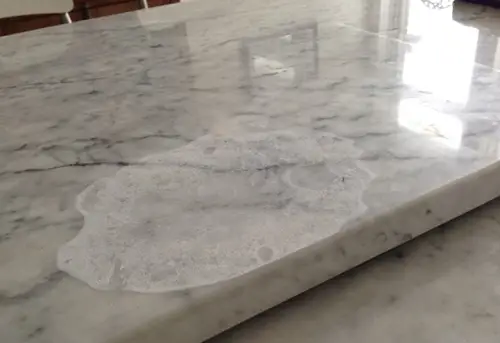
First and foremost, let’s define what a hard water stain is and isn’t. It’s critical to know the difference so you don’t utilize the wrong remedy to remove your problem, resulting in more damage to the surface.
A mineral deposit buildup on your kitchen countertops is known as a hard water stain. It has a matte look and feels slightly bumpy to the touch.
A water stain is not the same as an etch mark, which might be confused with it. The rough etch mark is created by an acidic substance (certain foods, citrus-based cleaning sprays, etc.) chemically reacting with the marble or granite and eating away the surface, resulting in a modest depression that feels rough.
[product_card_static label=”Weiman Disinfectant Granite Daily Clean & Shine” link=”https://www.amazon.com/dp/B00H341S5C/?tag=shmulshmulcleaninglab-20″ image=”https://cleaningproductslab.com/wp-content/uploads/2021/09/Weiman-109-Polish-24-Ounces-Non-Enhances.jpg” title=”Kills 99.9% of germs & bacteria, Kills the following bacteria in 10 minutes on hard, non-porous surfaces” btn_color=”#ffa226″ btn_name=”CHECK PRICE”]
Hard water stains on marble countertops are caused by hard water, which has minerals including calcium and magnesium in it. As the water evaporates, the mineral deposits adhere to the marble or granite surface, making those tell-tale dull regions more obvious.
Keeping your marble or granite countertops dry and clean is simple; all you have to do is be careful about keeping them wet and filthy.
Hard water stains are most likely to appear in your sink, where water splashes against the sides and backsplash of your granite or marble countertops all the time. Follow with a dry cloth to completely dry those areas after using the sink. Similarly, leave no water to dry naturally anywhere on your counters—even thin, wet smears will eventually dull your surfaces.
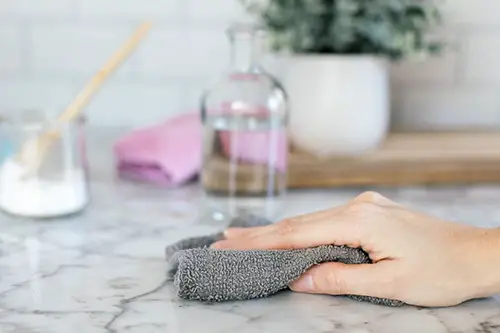
Different sorts of stains need different cleaning chemicals. Cleaning your marble with a mildew stain, rust, or etch-mark remover has little effect on water spots.
Our experts have a wide range of cleaning services available, including water damage cleanup and mold removal. We can also clean granite countertops and remove stains from that surface using various cleaning techniques.
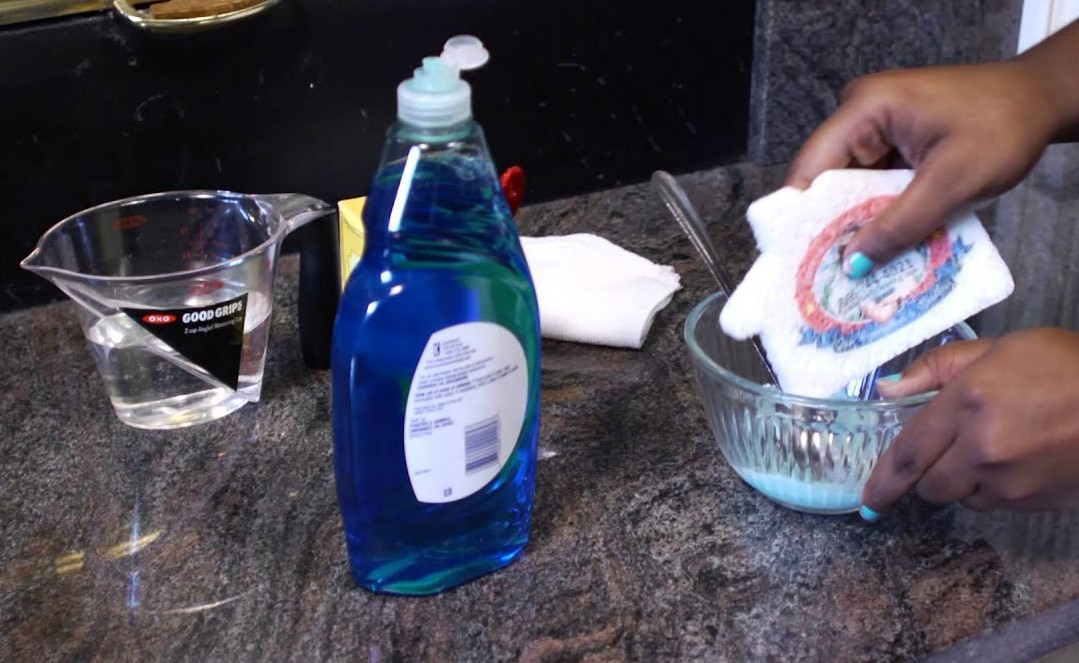
Sometimes, the simplest method to get rid of a stain from marble, faucets, and other surfaces is to use simple materials. To remove light water stains, try a DIY marble cleaner made with a mild soap and warm water.
Marble Stain Cleanser
Fill a container or bucket halfway with water and then add the liquid soap. With your hand, combine them. To clean marble, use Calgon or a mild dish soap. Dry 0000 steel wool should be used to softly buff the region to remove water stains and rings.
Use a damp cloth to gently wipe the water stain with a soft sponge. Using a circular motion, wash the water stain lightly. Continue adding the soapy water until the blemish disappears. To totally dry the marble, use a soft towel.
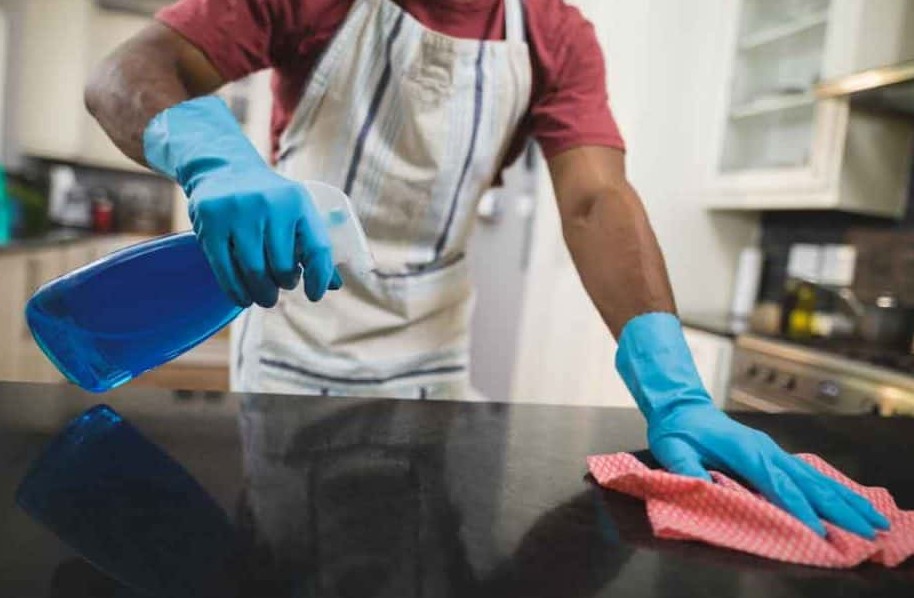
Cleaning stains off of natural stone surfaces such as marble and travertine with common cleaners like white vinegar and lemon juice is difficult because they are too acidic. These solutions tend to etch the surface and compromise the sealant.
[product_card_static label=”Granite Gold Daily Cleaner” link=”https://www.amazon.com/dp/B000BZWG0G/?tag=shmulshmulcleaninglab-20″ image=”https://cleaningproductslab.com/wp-content/uploads/2021/09/B000BZWG0G.jpg” title=”Natural stone cleaning solution never leaves behind unsightly streaks or smudges. Simply spray on and wipe down with a paper towel or lint-free cloth for a sparkling result.” btn_color=”#ffa226″ btn_name=”CHECK PRICE”]
Commercial cleaning products made specifically for marble can help you remove water stains. Many of these chemicals are also appropriate for cleaning marble tile flooring.
Marble Cleaner Water Spot Remover
Follow the directions for your marble cleaner. Spray a little water on the spot and then dust it with a tiny amount of the remover until it is damp. Wring out the cleaning solution using a circular motion on the marble surface. Towel dry the cloth and clean off the marble surface. To keep the surface looking new, use a marble polishing powder in place of a polish.

Baking soda is a natural powder that is alkaline and abrasive. This natural component can be used as a safe alternative for removing scum and stains from stone surfaces. Here’s how to make a baking soda poultice to remove water stains from marble.
Baking Soda Water Stain Remover
Add enough water to a container or bowl with some baking soda to form a thick paste. Apply the paste to the stain, rubbing in a circular motion to cover the entire area. Spread plastic wrap over the spot and leave it for 24 hours. Remove the plastic and use a wet cloth to wipe away any dried paste that has appeared.
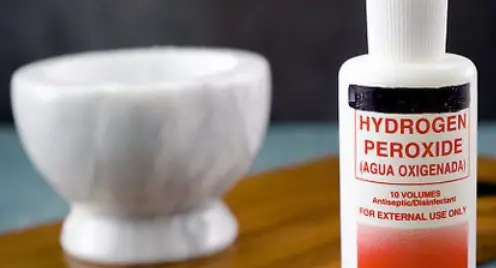
When attempting to remove stains from natural stones, it is tempting to reach for a bottle of bleach, but this is a bad idea because it damages the sealer.
A hydrogen peroxide solution is a mild bleaching agent and an oxidizing agent that may be used to remove stains from marble safely. It’s also good for removing stains from white marble, albeit only if the marble is light in color.
Hydrogen Peroxide Water Stain Removal
Sprinkle a scant amount of cream of tartar on the stain, then add enough hydrogen peroxide to make a thick paste. Using a soft rubbing motion, massage the solution onto the stain. Cover it with paper towels and leave it to sit for approximately 30 minutes. Remove all traces of residue by using a clean, damp cloth. This paste is also effective against various surfaces, including granite and glass, as a natural hard water stain remover.

It’s easy to overlook water droplets on your marble counters and floors, but doing so allows mineral deposits to form water stains. As a result, it’s critical to address spills as soon as possible.
Water Stain Prevention
The easiest way to prevent water spots and stains on your marble countertops is regular marble cleaning and keeping the surface dry. Absorb water spills with a paper towel as soon as possible, then clean the surface area with a soft cloth. To avoid the formation of water rings on the marble surface, make sure water glasses are always placed on coasters. Regularly clean your marble with mild soapy water to keep it looking its best.
[product_card_static label=”TriNova Granite Sealer & Protector – Best Stone Polish” link=”https://www.amazon.com/dp/B01AB21E4M/?tag=shmulshmulcleaninglab-20″ image=”https://cleaningproductslab.com/wp-content/uploads/2021/09/B01AB21E4M.jpg” title=”Great for Quartz, Marble, Granite, Quartzite, and Soapstone. ” btn_color=”#ffa226″ btn_name=”CHECK PRICE”]
Water rings and splatters of dull water stains ruin a once gleaming and lovely polished marble surface, making it an eyesore. Try using mild cleaners to restore the clean shine of marbles with stained surfaces or damaged areas instead of removing the whole item or ignoring them.
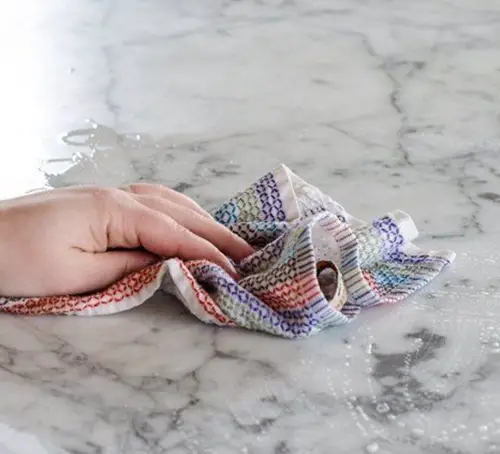
Marble is a delicate and sensitive material. Even when properly sealed, it can be prone to stains, dents, and scratches because of its softness. Any substance with a high acidity level, such as citrus fruit, vinegar, juice, coffee, or wine for example , has the potential to damage the surface of your marble and should be avoided.
The greatest and most basic method to safeguard your marble countertops is to take preventative measures. Keep coasters, cutting boards, and placemats handy. Before putting anything on the counter, make sure it’s in a bowl or plate so that citrus fruits, tomatoes, and other acidic foods aren’t splashed around. Avoid spattering vinegar, wine, or oil onto the marble since we’re all humble beings.
It’s critical to keep your marble countertop clean on a regular basis, at the very least several times a day, depending on how much you use it. If you’re only doing basic cleaning, a soft cloth and warm water will do the job. However, if you want to be more thorough, choose a mild, natural soap with a neutral pH that everyone loves. A good stone cleaner may also come in useful if an incident is not noticed for too long and begins to set up. Ask your hardware store for recommendations on the best stone cleaners and read the label to ensure that they’re designed especially for stones. If a stain won’t come out with soaps or stone cleaners, try poultice paste. Though it takes longer and is more difficult, it’s an old-fashioned stain removal method that has shown success in the past.
[product_card_static label=”Black Diamond Stoneworks GRANITE PLUS!” link=”https://www.amazon.com/dp/B002LGY10G/?tag=shmulshmulcleaninglab-20″ image=”https://cleaningproductslab.com/wp-content/uploads/2021/09/B002LGY10G.jpg” title=”2 in 1 Cleaner & Sealer for Granite, Marble, Travertine, Limestone, Ready to Use” btn_color=”#ffa226″ btn_name=”CHECK PRICE”]
Another method to clean granite is to use a paste made of lemon juice, water, and baking soda. Simply mix the three components together until they’re thoroughly blended, then spread it on your countertop as you’d do with any other paste. Additionally, keep a specific sponge or cloth on hand for use on your countertops, especially if you employ strong acids in the cleaning of other surfaces in your house. It’s possible that using the cloth you cleaned with a lemon cleanser for your bathroom vanity an hour later would be detrimental. After finishing cleaning the marble surface, make sure to dry it with a clean towel rather than using it again right away.
To complete your marble protection strategy, maintain your countertop sealed. We’d be willing to recommend some of the area’s top local fabricators as a result of our relationship with them.
You may also attempt to seal marble worktops yourself. Before purchasing, thoroughly read the label of any sealant recommended by your local hardware shop. Sealants can range from every six months to every decade in terms of frequency of usage. However, it’s best to seal your countertop once every six months to a year to ensure that your marble maintains its best possible state for as long as possible.
A lifetime benefit of marble accrues to any surface made from this stone, whether it’s polished or unpolished. Water stains decrease the value of marble and can even damage all of its characteristics if left unchecked. But you won’t because the techniques for removing water stains are simple to follow and the components may be found at home. You must keep your marble looking beautiful by wiping away any moisture as soon as possible so that stains don’t accumulate.
Did you see our favorites?
CleaningProductsLab.com is a participant in the Amazon.com Services LLC Associates Program. As an Amazon Associate we earn from qualifying purchases.
Amazon and the Amazon logo are trademarks of Amazon.com, Inc. or its affiliates.
The information on this blog is not meant as a substitute for medical advice, and should not be taken as such.